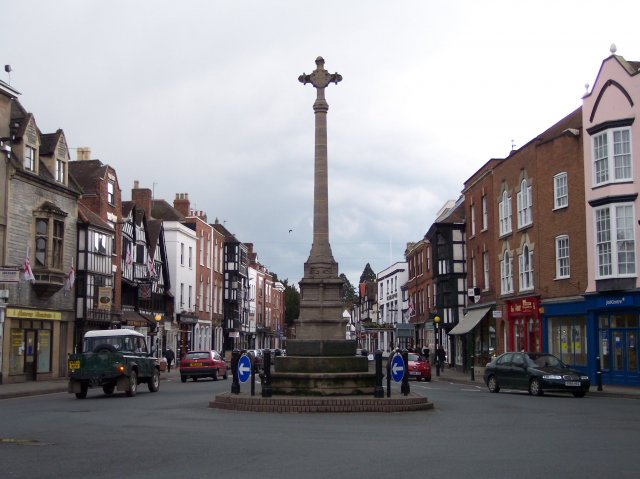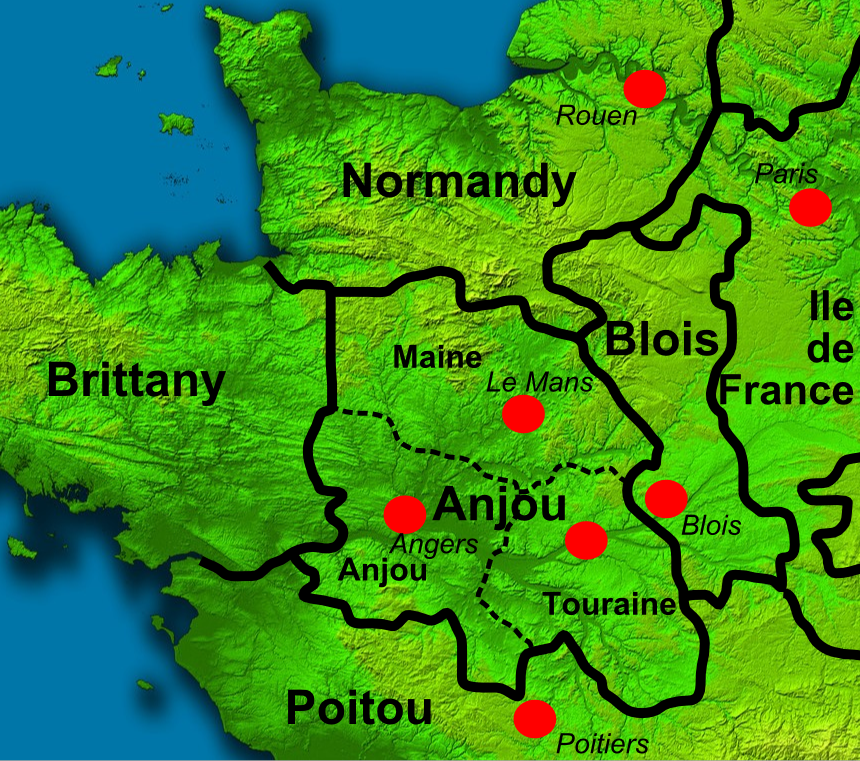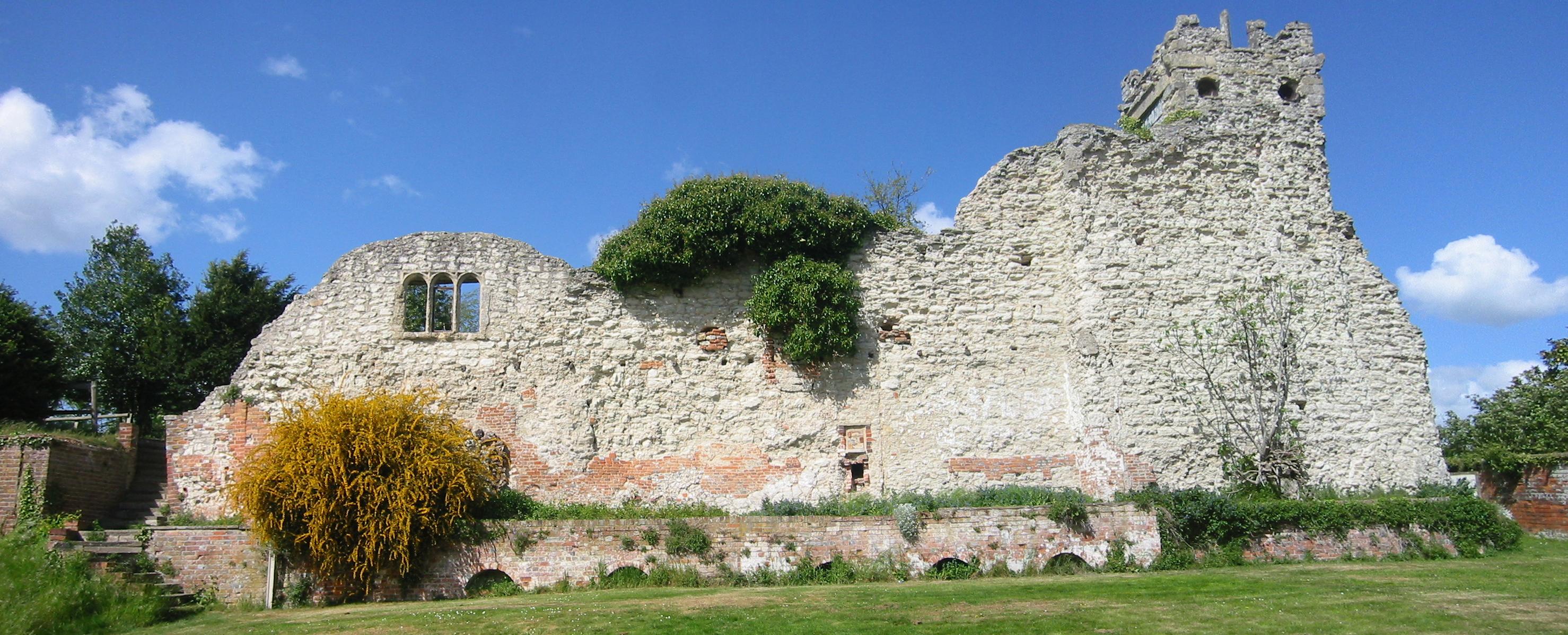|
Waleran De Beaumont, 1st Earl Of Worcester
Waleran de Beaumont (1104–1166) was an Anglo-Norman nobleman. In his early adulthood, he was a member of the conspiracy of Amaury III of Montfort; later in his career, he participated in the Anarchy and the Second Crusade. During the reign of Henry II of England, Waleran's close ties to Louis VII of France caused him to fall out of grace. Early life Waleran was born in 1104, the elder of twin sons of Robert de Beaumont, 1st Earl of Leicester, and Elizabeth of Vermandois, Countess of Leicester. On their father's death in June 1118, the boys came into the wardship of King Henry I of England. They remained in his care till late in 1120 when they were declared adult and allowed to succeed to their father's lands by a division already arranged between the king and their father before his death. By the arrangement, Waleran succeeded to the county of Meulan upriver on the Seine from the Norman border, and the principal family Norman honors of Beaumont-le-Roger and Pont Audemer. Hi ... [...More Info...] [...Related Items...] OR: [Wikipedia] [Google] [Baidu] |
Montfort-sur-Risle
Montfort-sur-Risle (, literally ''Montfort on Risle'') is a commune in the Eure department in Normandy region in northern France. History In Gallic times the river Risle delimited the territories of the tribes of Veliocasses and the Lexovii. Between 980 and 1204, when it passed into the hands of the King of France with its castle, Montfort-sur-Risle was a lordship. The most famous Lord of Montfort was Hugues II de Montfort (died 1083), who joined in the Norman conquest of England, for which he received 114 English manors. Geography The commune along with another 69 communes shares part of a 4,747 hectare, Natura 2000 conservation area, called Risle, Guiel, Charentonne. Population See also *Communes of the Eure department The following is a list of the 585 communes of the Eure department of France France, officially the French Republic, is a country located primarily in Western Europe. Overseas France, Its overseas regions and territories include French G .. ... [...More Info...] [...Related Items...] OR: [Wikipedia] [Google] [Baidu] |
Tewkesbury
Tewkesbury ( ) is a market town and civil parish in the north of Gloucestershire, England. The town grew following the construction of Tewkesbury Abbey in the twelfth century and played a significant role in the Wars of the Roses. It stands at the confluence of the River Severn and the River Avon, and thus became an important trading point, which continued as railways and, later, the M5 and M50 motorway connections were established. The town gives its name to the Borough of Tewkesbury, a local government district of Gloucestershire. The town lies on the border with Worcestershire, marked largely by the Carrant Brook (a tributary of the River Avon). The name Tewkesbury is thought to come from Theoc, the name of a Saxon who founded a hermitage there in the 7th century, and in the Old English language was called '. An erroneous derivation from Theotokos (the Greek title of Mary, mother of God) enjoyed currency in the monastic period of the town's history. The Battle of Tew ... [...More Info...] [...Related Items...] OR: [Wikipedia] [Google] [Baidu] |
Sudeley
Sudeley is a civil parish in the district of Tewkesbury, in the county of Gloucestershire, England. The parish includes the village of Charlton Abbots. History The parish was formed on 1 April 1935 from the parishes of Charlton Abbots and Sudeley Manor and part of Sevenhampton. The name "Sudeley" means 'South wood/clearing' or perhaps, 'shed wood/clearing'. Sudeley was recorded in the Domesday Book as ''Sudlege''. Places of interest The parish is home to Sudeley Castle a Grade I listed In the United Kingdom, a listed building is a structure of particular architectural or historic interest deserving of special protection. Such buildings are placed on one of the four statutory lists maintained by Historic England in England, Hi ... listed building. References External links Civil parishes in Gloucestershire Borough of Tewkesbury {{Gloucestershire-geo-stub ... [...More Info...] [...Related Items...] OR: [Wikipedia] [Google] [Baidu] |
Roger Of Salisbury
Roger of Salisbury (died 1139), was a Norman medieval bishop of Salisbury and the seventh Lord Chancellor and Lord Keeper of England. Life Roger was originally priest of a small chapel near Caen in Normandy. He was called "Roger, priest of the church of Avranches", in his notification of election to the bishopric. The future King Henry I, who happened to hear mass there one day, was impressed by the speed with which Roger read the service and enrolled him in his own service. According to William of Newburgh, Roger was poor and uneducated, but this is considered unlikely by the historian B. R. Kemp. On coming to the throne, Henry almost immediately made him Chancellor in 1101. He held that office until late 1102. On 29 September 1102 Roger received the bishopric of Salisbury at Old Sarum Cathedral, but he was not consecrated until 11 August 1107 owing to the dispute between Henry and him. He was consecrated at Canterbury. During the dispute between Henry and Archbishop Ans ... [...More Info...] [...Related Items...] OR: [Wikipedia] [Google] [Baidu] |
Robert, 1st Earl Of Gloucester
Robert FitzRoy, 1st Earl of Gloucester (c. 1090 – 31 October 1147 David Crouch, 'Robert, first earl of Gloucester (b. c. 1090, d. 1147)', Oxford Dictionary of National Biography, Oxford University Press, 2004; online edn, May 200Retrieved 1 October 2010/ref>) (''alias'' Robert Rufus, Robert de Caen ( Latinised to Robertus de Cadomo), Robert Consul) was an illegitimate son of King Henry I of England. He was the half-brother of the Empress Matilda, and her chief military supporter during the civil war known as the Anarchy, in which she vied with Stephen of Blois for the throne of England. Early life Robert was probably the eldest of Henry's many illegitimate children. He was born before his father's accession to the English throne, either during the reign of his grandfather William the Conqueror or his uncle William Rufus. He is sometimes and erroneously designated as a son of Nest, daughter of Rhys ap Tewdwr, last king of Deheubarth, although his mother has been id ... [...More Info...] [...Related Items...] OR: [Wikipedia] [Google] [Baidu] |
Roger De Toeni
Roger I of Tosny or Roger of Hispania (died c. 1040) was a Norman nobleman of the House of Tosny who took part in the Reconquista of Iberia. Career Roger was the son of Raoul I of Tosny, seigneur de Conches. In 1013, Roger and his father guarded the castle at Tillières for Richard II, Duke of Normandy. A few years later, for an unknown reason, the pair were forced into exile and Tilliéres was taken from their custody (later given to Gilbert Crispin by Robert II). While his father gained a reputation for himself in Apulia, Roger did the same fighting the Muslims in Northern Iberia, where the Christian states welcomed volunteers. Roger fought for Ermesinde of Carcassonne, regent-countess of Barcelona after the death of her husband Ramon Borrell, helping her against the Muslim. Maybe Roger married Ermesinde's daughter. Adémar de Chabannes gives an echo of the more or less legendary deeds of Roger in Iberia, where he gained the nickname ''Mangeur de Maures'' (Moor-Eater). Ad� ... [...More Info...] [...Related Items...] OR: [Wikipedia] [Google] [Baidu] |
Empress Matilda
Empress Matilda (10 September 1167), also known as Empress Maud, was one of the claimants to the English throne during the civil war known as the Anarchy. The daughter and heir of Henry I, king of England and ruler of Normandy, she went to Germany as a child when she was married to the future Holy Roman Emperor Henry V. She travelled with the emperor to Italy in 1116, was controversially crowned empress in St Peter's Basilica, and acted as the imperial regent in Italy. Matilda and Henry V had no children, and when he died in 1125, the imperial crown was claimed by his rival Lothair of Supplinburg. Matilda's younger and only full brother, William Adelin, died in the ''White Ship'' disaster of 1120, leaving Matilda's father and realm facing a potential succession crisis. Upon her widowhood in the Holy Roman Empire, Matilda was recalled to Normandy by her father, who arranged for her to marry Geoffrey of Anjou to form an alliance to protect his southern borders in Franc ... [...More Info...] [...Related Items...] OR: [Wikipedia] [Google] [Baidu] |
Geoffrey Of Anjou
Geoffrey V (24 August 1113 – 7 September 1151), called the Fair (), Plantagenet, and of Anjou, was the count of Anjou and Maine by inheritance from 1129, and also duke of Normandy by his marriage claim and conquest, from 1144. Geoffrey married Empress Matilda, daughter of Henry I, king of England and duke of Normandy. Geoffrey and Matilda's marriage led, through their son Henry II, to the 300-year long reign of the Plantagenet dynasty in England. Although it was never his family name or last name, "Plantagenet" was taken for the dynasty from Geoffrey's epithet, long after his death. Geoffrey's ancestral domain of Anjou in north central France gives rise to the name Angevin, and what modern historians name as the Angevin Empire in the 12th century. Early life Geoffrey was the elder son of Fulk V of Anjou and Ermengarde of Maine. The chronicler John of Marmoutier described Geoffrey as handsome, red haired, jovial, and a great warrior. King Henry I of Engla ... [...More Info...] [...Related Items...] OR: [Wikipedia] [Google] [Baidu] |
Stephen Of England
Stephen (1092 or 1096 – 25 October 1154), often referred to as Stephen of Blois, was King of England from 22 December 1135 to his death in 1154. He was Count of Boulogne '' jure uxoris'' from 1125 until 1147 and Duke of Normandy from 1135 until 1144. His reign was marked by the Anarchy, a civil war with his cousin and rival, the Empress Matilda, whose son, Henry II, succeeded Stephen as the first of the Angevin kings of England. Stephen was born in the County of Blois in central France as the fourth son of Stephen-Henry, Count of Blois, and Adela, daughter of William the Conqueror. His father died as a crusader while Stephen was still young, and he was brought up by his mother. Placed into the court of his uncle Henry I of England, Stephen rose in prominence and was granted extensive lands. He married Matilda of Boulogne, inheriting additional estates in Kent and Boulogne that made the couple one of the wealthiest in England. Stephen narrowly escaped drowning w ... [...More Info...] [...Related Items...] OR: [Wikipedia] [Google] [Baidu] |
Wallingford Castle
Wallingford Castle is a medieval castle situated in Wallingford in the English county of Oxfordshire (historically Berkshire), adjacent to the River Thames. Established in the 11th century as a motte-and-bailey design within an Anglo-Saxon ''burgh'', it grew to become what historian Nicholas Brooks has described as "one of the most powerful royal castles of the 12th and 13th centuries". Held for the Empress Matilda during the civil war years of the Anarchy, it survived multiple sieges and was never taken. Over the next two centuries it became a luxurious castle, used by royalty and their immediate family. After being abandoned as a royal residence by Henry VIII, the castle fell into decline. Refortified during the English Civil War, it was eventually slighted, i.e. deliberately destroyed, after being captured by Parliamentary forces after a long siege. The site was subsequently left relatively undeveloped, and the limited remains of the castle walls and the considerable ear ... [...More Info...] [...Related Items...] OR: [Wikipedia] [Google] [Baidu] |
Bridgnorth
Bridgnorth is a market town and civil parish in Shropshire, England. The River Severn splits it into High Town and Low Town, the upper town on the right bank and the lower on the left bank of the River Severn. The population at the United Kingdom Census 2011, 2011 Census was 12,079. History Bridgnorth is named after a bridge over the River Severn, which was built further north than an earlier bridge at Quatford. The earliest historical reference to the town is in 895, when it is recorded that the Danes (Germanic tribe), Danes created a camp at ''Cwatbridge''; subsequently in 912, Æthelfleda constructed a mound on the west bank of the River Severn, or possibly on the site of Bridgnorth Castle, as part of an offensive against the Danes. Earliest names for Bridgnorth include Brigge, Brug and Bruges, all referring to its position on the Severn. After the Norman conquest of England, Norman conquest, William the Conqueror, William I granted the manorialism, manor of Bridgnorth to R ... [...More Info...] [...Related Items...] OR: [Wikipedia] [Google] [Baidu] |







